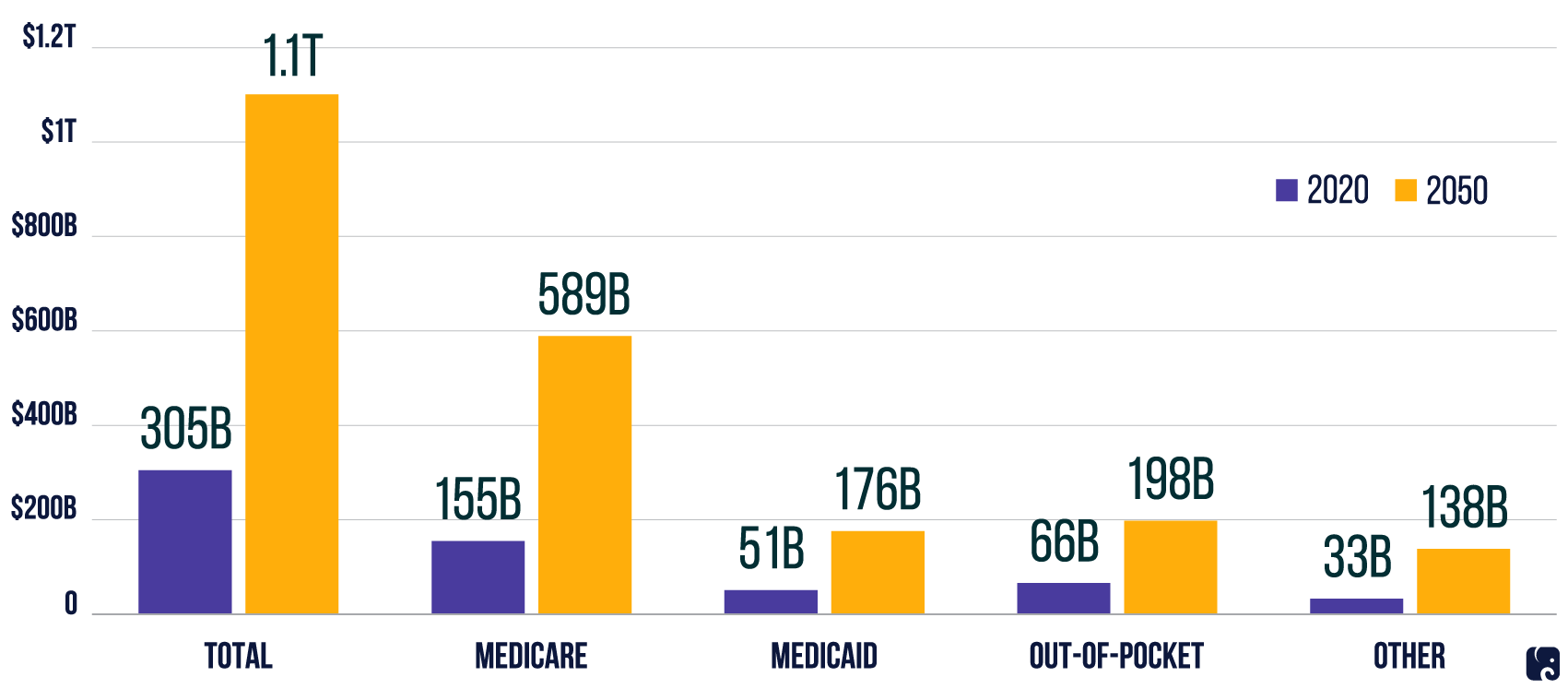The Rising Toll of Alzheimer's Disease
KEY TAKEAWAYS
- Alzheimer’s disease currently afflicts 5.8 million Americans ages 65 and older, a number expected to reach 13.5 million by 2050.
- The cost of caring for people with Alzheimer’s and other forms of dementia is expected to increase from $305 billion this year to $1.1 trillion by 2050, with Medicare and Medicaid paying roughly 70% of the total cost.
- Congress provided $2.8 billion to the National Institutes of Health in fiscal year 2020 for Alzheimer’s-related research to better detect the disease, prevent or delay its onset, and find treatments and cures.
Alzheimer’s disease is the most common form of dementia and the sixth-leading cause of death in the United States. The disease is irreversible and affects a person’s memory, perception, and personality. It also disrupts bodily functions in ways that can ultimately lead to death. It is estimated that today 5.8 million Americans ages 65 and older have Alzheimer’s – about 10% of the population in that age group. By 2050 this figure is projected to more than double to 13.5 million people, or 16% of the over-65 population.
People 65 and Older with Alzheimer’s

Scientists have yet to discover the exact cause of the degenerative disease, and many believe the causes may be a combination of genetic, environmental, and lifestyle factors. It is known that the risk of Alzheimer’s disease increases with age. As the number of older Americans is growing, so is the expected number of cases of Alzheimer’s disease.
rising costs threaten budgets
Alzheimer’s not only affects people afflicted with the disease but also their caregivers, the health care system, and the economy. According to the Alzheimer’s Association, more than 16 million Americans support someone with some form of dementia as unpaid caregivers. These are typically family members and friends who take time away from work or other activities to care for their loved one, assisting with daily living activities, finances, and managing the patient’s health. The organization estimates that last year caregivers provided $244 billion in unpaid care to people with Alzheimer’s or other forms of dementia.
Who Pays to Care for People with Dementia?

The financial toll of Alzheimer’s on the health care system and federal and state budgets is also substantial. As the population ages and life expectancy increases, there will be a greater need for a variety of long-term care services. It is likely that the burden of paying for this care will fall mostly on taxpayers.
The majority of dementia patients receive Medicare benefits; depending on their disability or financial eligibility, some also qualify for Medicaid. The Medicaid program, which is funded in part by state budgets, covers the cost of long-term care and other support for dementia patients. Today, payments for the care of people living with Alzheimer’s or other forms of dementia are estimated at $305 billion. Medicare and Medicaid are estimated to cover two-thirds of the cost – $206 billion– with patients paying $66 billion out of pocket. By 2050, the total cost is projected to top $1.1 trillion, with government entitlement programs paying nearly 70%.
research and Prevention efforts
There are currently no medications available to help prevent or treat Alzheimer’s disease. Over the past several years, Congress has made it a priority to increase funding for research to better detect the disease, identify treatments to prevent or delay its onset, and develop a cure. For fiscal year 2020, Congress provided the National Institutes of Health $2.8 billion for research into Alzheimer’s disease and other types of dementia, an increase of $350 million from the previous year. The National Institute on Aging is currently studying potential ways to prevent cognitive decline and dementia. Trials are underway to better understand the role of diet, exercise, and other lifestyle factors in reducing the risk of cognitive decline and preventing Alzheimer’s.
The Department of Health and Human Services released a National Plan to Address Alzheimer’s Disease in 2012. It set out a strategy to increase public awareness of the disease, support caregivers, promote research, and effectively treat the disease by 2025. Identifying effective treatments may reduce the financial burden of Alzheimer’s on families, taxpayers, and the health care system. The Alzheimer’s Association estimates a treatment that could delay the onset of the disease by five years would save $367 billion a year by 2050.
In 2018, Congress passed and President Trump signed into law the BOLD Infrastructure for Alzheimer’s Act. This legislation aimed to treat Alzheimer’s disease as a public health issue by improving public awareness, better detecting initial symptoms, and translating promising research into interventions in the hope of shifting the course of the disease.
While most dementia patients are older, younger people also can develop it. The Supporting Older Americans Act of 2020 – passed by Congress and signed into law in March – reauthorized the Older Americans Act through fiscal year 2024. The legislation changed the definition of “family caregiver” to include caregivers of patients of any age with Alzheimer’s disease. This change allows certain caregiver support services to be extended to caregivers of patients with early-onset Alzheimer’s disease.
Next Article Previous Article
